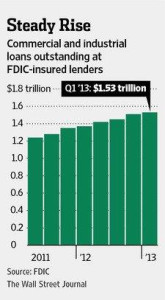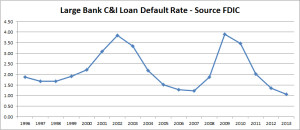At the Oct, 2013 TMA Annual, and for two weeks after, I met with a score of companies in the turnaround industry. Nearly all of them were suffering from weak revenues. Even worse, after 4-5 years of diminishing work, most firms still had no confidence that things would get better any time soon.
Unfortunately, it appears as if structural issues within the industry substantiate this lack of confidence.
 When the decline in industry case work began 4-5 years ago, it was believed that the decline was tied to the decrease in loan activity – i.e. the “credit crunch”. It was further believed that turnaround case work would rebound when lending rebounded. However, this linkage has been broken. As this WSJ chart shows, while turnaround cases continue to be depressed, commercial lending has been growing for at least 2 years and is again at record volume levels.
When the decline in industry case work began 4-5 years ago, it was believed that the decline was tied to the decrease in loan activity – i.e. the “credit crunch”. It was further believed that turnaround case work would rebound when lending rebounded. However, this linkage has been broken. As this WSJ chart shows, while turnaround cases continue to be depressed, commercial lending has been growing for at least 2 years and is again at record volume levels.
It is now believed by most, that turnaround industry cases may only regain momentum once C&I loan default rates increase and once banks recognize more loans as troubled or non-performing.
The first part of that equation is not looking promising for the turnaround industry. Current commercial C&I interest rates may be at their lowest levels ever.

The current record low default rates are not because debtors have all of a sudden become better managers. Rather the rates are low because banks are simply not allowing their debtors to default. Before loans become TDR’s or Non-Performing, banks are using cheap money to amend and extend the loans. They are also benefiting from cheap money by selling off the loans they don’t want to an ocean of willing and hungry secondary lenders. Finally, as of late, and much to the dismay of some regulators, banks are working with hedge funds to construct and then deal in capital relief trades – CRT’s.
In each of these scenario’s, loans that have been originated in record numbers are never going over to the traditional work-out groups within banks and as such are not becoming cases for the turnaround industry to work with.
Will this dynamic change anytime soon? It is highly doubtful. If anything, regulators will make capital coverage requirements even more expensive for troubled loans – lessening further banks willingness to declare them as TDR’s or non-performing. Moreover, as we have seen even in today’s newspapers, the Fed is now likely to not even begin tapering its bond buying until 2014 – so money will stay cheap at least until then.
Perhaps regulators may step in to cut back on the use of CRT’s but even so, banks will still have many other options open to them to keep loans and debtors from defaulting.
When all is said and done, the prognosis for the turnaround industry is not good (assuming the economic terrorists in DC do not cause the US to default on its debt). Accordingly, for firms to maintain or grow their businesses in this environment, they must adapt specific, and likely out of the box growth strategies.
That will be the subject of a future blog post.